|
1 |
Lewis Carroll's |
 |
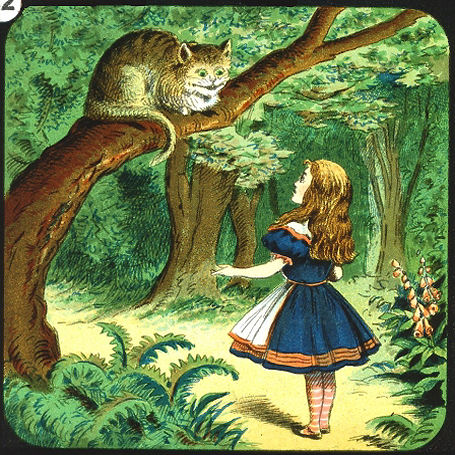 |
 1865. The
English author Charles Lutwidge Dodgson wrote under his pseudonym Lewis Carroll
the famous novel Alice's Adventures in Wonderland. The story (commonly
shortened to Alice in Wonderland) is now known by everyone.
A girl named Alice falls through a rabbit hole into a fantasy world populated by
peculiar, anthropomorphic creatures. The book is considered to be one of the
best examples of the literary nonsense genre. 1865. The
English author Charles Lutwidge Dodgson wrote under his pseudonym Lewis Carroll
the famous novel Alice's Adventures in Wonderland. The story (commonly
shortened to Alice in Wonderland) is now known by everyone.
A girl named Alice falls through a rabbit hole into a fantasy world populated by
peculiar, anthropomorphic creatures. The book is considered to be one of the
best examples of the literary nonsense genre. |
||
|
The Junior Lecturers Series was produced by W. Butcher & Sons, London (1870-1906) under the trade name
'Primus'. The slides were sold as a set of eight in a cardboard box. The complete series was divided into three series, A, B and C. Series A was described as 'comic tales and nursery stories, with reading on the slides'. Series B and C had accompanying readings printed on paper lecture notes. A long story as Alice in Wonderland had to be adjusted to conform with the concept of the Junior Lecturers' Series, implying that the sets always had to consist of boxes of eight slides. If more, they had to be divided in chapters each of eight slides. Sometimes this lead to problems. Some stories had to be expanded, others had to be cut short, like in the case of Alice. Here the problem was one of cutting down the original 42 drawings by John Teniel to fit the pattern of 24 slides. The decision to restrict the story to only 3 chapters was possibly because it could become tedious when told completely. 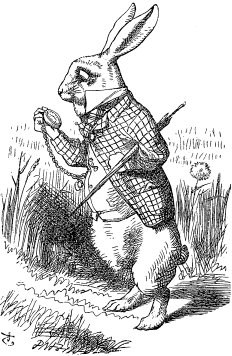 It should have been hard
for the designers to decide which of the well known drawings of John Teniel had to perish
here. We certainly miss some of the most memorable images from the book, like
the White Rabbit looking at his watch, Alice and the 'Drink Me' bottle, and the
Cheshire Cat disappearing, leaving only his grin behind. In other sets that
permit dissolving views the Cheshire Cat scene could have been a wonderful event,
but unfortunately the JLS concept does not. It should have been hard
for the designers to decide which of the well known drawings of John Teniel had to perish
here. We certainly miss some of the most memorable images from the book, like
the White Rabbit looking at his watch, Alice and the 'Drink Me' bottle, and the
Cheshire Cat disappearing, leaving only his grin behind. In other sets that
permit dissolving views the Cheshire Cat scene could have been a wonderful event,
but unfortunately the JLS concept does not.While almost all slides are adaptations of Teniel's drawings, some slides, like the title slide, are wholly the work of the slide makers. Sometimes some Teniel drawings were combined to one: slide 3 combines elements from four rejected drawings. Carroll should not have been happy with the addition of colours to the black and white originals which is in the tradition of the JLS rather gaudy. On seeing the first edition of 'The Nursery Alice' for which 20 of the original drawings were reproduced in colour, he rejected it immediately. He directed that none of the ten thousand copies were to be sold in England and called at once for a second edition with colouring that was less gaudy. In spite of the manufacturers claim that the slides were produced 'in a most perfect manner from Sir John Tenniel's original drawings' (see add) the illustrations differ from them to a considerable degree mainly caused by the necessity to produce square lantern slides from originals in a wide variety of shapes. |
|||
 |
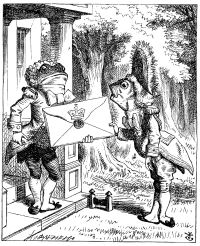 |
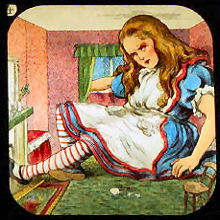 |
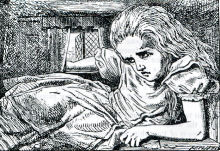 |
|
In some slides the figures of Alice and
The White Rabbit are placed in the background where they do no appear in the
original drawings. Alice is clearly the protagonist and that's why all things are build up
around her. This also concerns The White Rabbit that also plays an important
role in the story. |
A good example of the problems that occur when an original
picture has to be adapted to a square slide. Alice is now shown sitting up in an
attempt by the slide artist to fill the empty space. Alas this is only partial
succeeded which dissipates the claustrophobic feeling of the original. |
||
 |
||
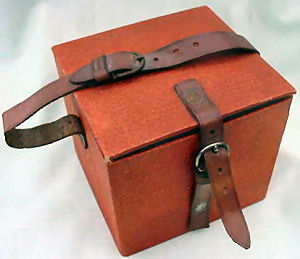 |
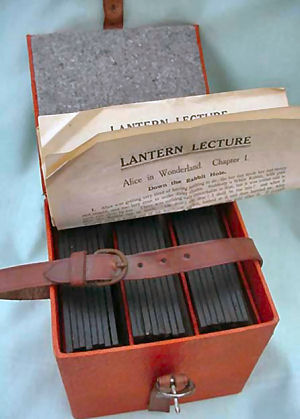 |
 |
| Of course the slides were mainly sold in the usual cardboard boxes. Sometimes large series like Alice were also sold in boxes that could contain all the chapters together with the accompanying readings. | ||
|
Below is the complete set of the 'curved version'. What is the 'curved version'? We'll explain you later. 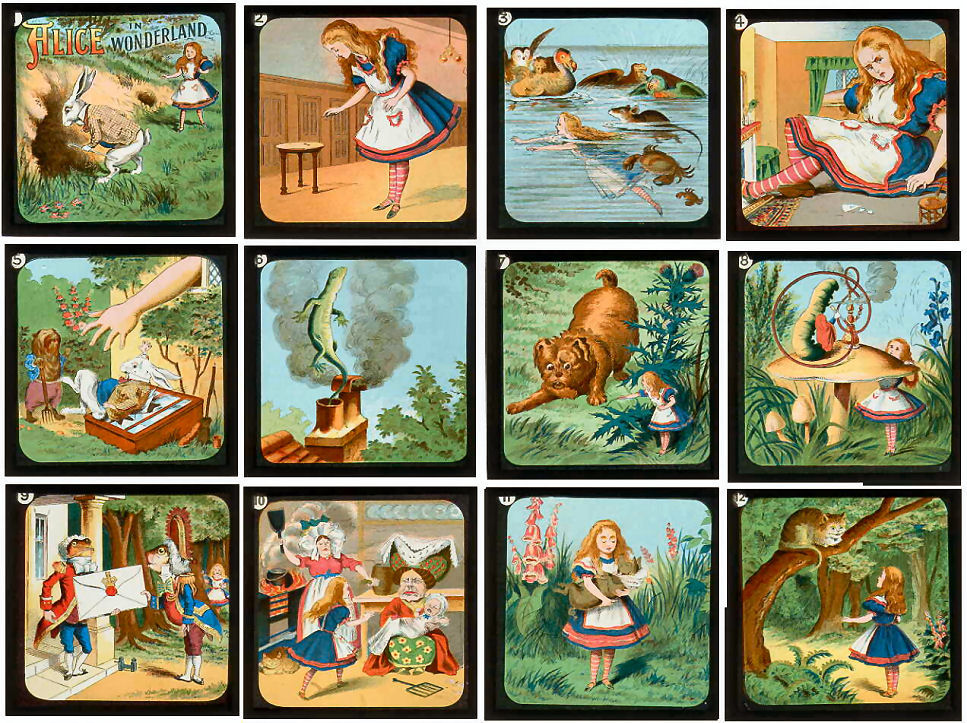  |
|
Two states of the same set. The slides of Alice in Wonderland can be found in (at least) two versions. That there is a difference is already revealed in the title on the first slide. One version shows the word 'Wonderland' printed in a curved line; the other version has this part of the caption printed in a straight horizontal line. For convenience we will call these two versions in future the 'curved version' and the 'straight version' respectively. It is not easy to determine which of the two versions was first. The curved version is of a clearly better quality, where the straight version looks sometimes cheap and nasty. Maybe the straight version was first and perhaps it is possible that Mr. Butcher at a certain moment thought: 'I think there is room for improvement' and summoned his artists to create an entire new set. Probably another vision is right. The carelessness about the straight set suggests that it is probably redrawn in a hurry at a time when further stocks were called for and the original plates were no longer available. A third possibility is that the straight set is not produced by Butcher at all, and is in fact a bad copy made by another producer. Such things happened in those days (and happen still nowadays) but yet this assumption is improbable because the straight version is represented in the adjacent Primus advertisement. |
 |
|
We will show here some differences between the two versions: |
||
 |
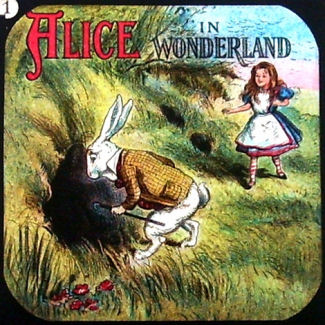 |
The word 'Wonderland' on the
second title slide is printed in a straight horizontal line while the other set has a
curved caption on this slide. In the curved version the figure of Alice is somewhat larger and the word 'Wonderland' is angled above her head as if to make room for her. |
 |
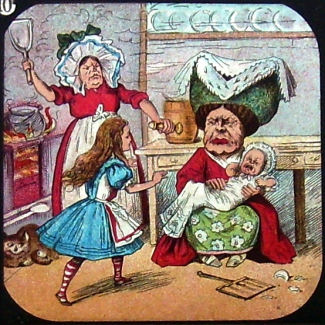 |
The images of the curved version are firmly
drawn with deep rich colours, while of the straight version the drawing is
rather perfunctory, the colours are rather weak and the details are less. See for instance the orange dots at the headgear of the Duchess, the bars of the stove and the steam that comes from the kettle on the fire. |
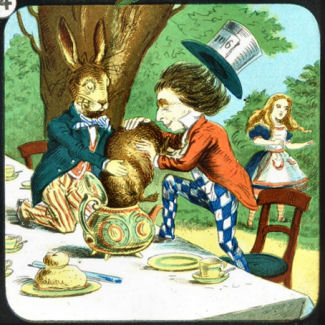 |
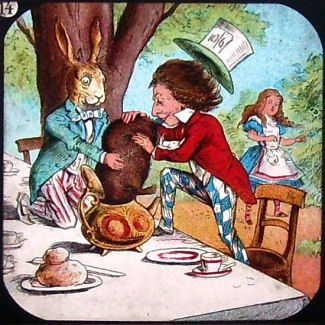 |
Colours of the clothes. The White Rabbit wears a red waistcoat in the curved version and a white waistcoat in the straight one. |
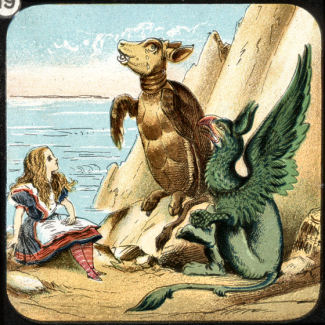 |
 |
In slide 19 of the curved version there is
a lobster-pot standing at the edge of the picture which is copied from the Tenniel
original.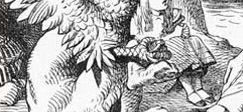 In the straight version this detail has been carelessly converted into a variation in shading of the rock. |
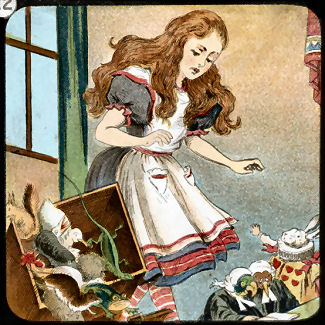 |
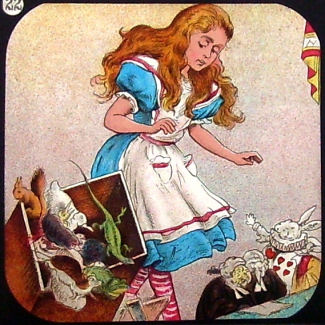 |
In slide 22 the straight version omits the window present in the curved version though it is still present in the preceding and following slides. |
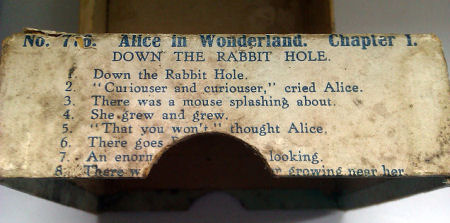 |
This site contains a comprehensive catalogue on all sets of the Primus Junior Lecturers' Series. The three chapters of 'Alice in Wonderland' are numbered 776 - 778. 776. Chapter 1. Down the Rabbit Hole. 777. Chapter 2. The Mad Tea Party. 778. Chapter 3. Who stole the Tarts. |
Other sets of magic lantern slides telling the story of Alice in Wonderland |
|
| |
©1997-2021 'de Luikerwaal' All rights reserved. Last update: 09-05-2021. |
|